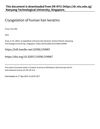Search
forLearn
3 / 3 resultslearn Epidermal Growth Factor
learn Osteopontin
signaling protein that, when suppressed, may grow hair by reducing inflammation and stem cell loss
Research
5 / 1000+ resultsresearch An Electron Microscopy Study of Keratin Degradation by the Fungus Microsporum Gypseum In Vitro
Microsporum gypseum fungus breaks down keratin in hair by digesting it enzymatically, starting with less keratinized parts.

research Bioabsorbable Nano-Micelle Hybridized Hydrogel Scaffold Prevents Postoperative Melanoma Recurrence
A special gel with medicine helps prevent melanoma from coming back after surgery.
research Human Hair Keratin and Its-Based Biomaterials for Biomedical Applications
Human hair keratin can be used in many medical applications.
research Current Insight of Peptide-Based Hydrogels for Chronic Wound Healing Applications: A Concise Review
Peptide-based hydrogels are promising for healing chronic wounds effectively.

research Cryogelation of Human Hair Keratins
Human hair keratins can be turned into useful 3D biomedical scaffolds through a freeze-thaw process.
Community Join
5 / 52 resultscommunity Is it a normal shed or is it fin not working (or making things worse)
The user experienced hair shedding after switching from minoxidil to finasteride and is considering switching to dutasteride or stopping pills altogether. They also stopped using a specific shampoo with probiotics, enzymatic exfoliator, zinc, and panthenol.
community I literally can’t find any evidence of sulfotransferase being upregulated by microneedling or retinoids like tretinoin
Microneedling and tretinoin may enhance minoxidil absorption for hair loss, but evidence on their effectiveness is limited. Iron supplements and broccoli sprouts are suggested for enzyme activation, but their impact on hair is unclear.
community Androgenetic alopecia is a skin disease: DHT-mediated skin disorders
Dihydrotestosterone (DHT) impacts various skin conditions, including Androgenetic alopecia and seborrheic dermatitis, by causing overactivity in sebaceous glands. Topical medications Tacrolimus and Clobetasol can reduce these inflammatory conditions, and treatments like RU58841, Minoxidil, and Finasteride may also be beneficial.
community Similar 5ar inhibitors to fin?
Natural vitamins like pumpkin seed oil, saw palmetto, and ecklonia cava are discussed for their potential to lower DHT levels. They may work similarly to finasteride but are significantly weaker.
community What Determines Sulfotransferase Enzyme Levels In The Body?
Some people have low sulfotransferase enzyme levels, affecting their response to minoxidil. Lifestyle factors, genetics, and diet, like MSM intake, might influence these enzyme levels.